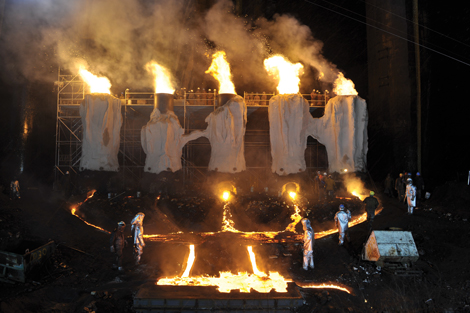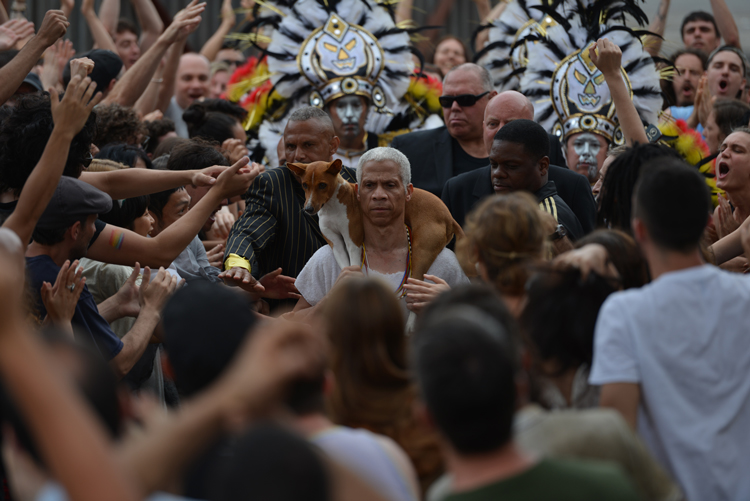Where do you start with a six-hour operatic extravaganza on sex, art, alchemy, reincarnation and the decline of the American auto industry, drenched in melodrama and symbology, with so many threads running through it that the original material, if any, is obscured; a film that is overflowing with comparisons between the reproductive, alimentary and industrial canals, and which, owing to its scatological and illogical nature, has already had every conceivable shit metaphor and piece of excremental wordplay applied to it?
One could start with an opening scene in which a filth-encrusted Matthew Barney—as the Ka of Norman—emerges from a sewer to stealthily penetrate the bowels of Norman Mailer’s Brooklyn brownstone. Naturally, he heads straight to the bathroom, where he wraps a turd in gold leaf, thereby summoning the presence of a mud-caked Egyptian pharaoh, equipped with a colostomy bag. Barney kneels before him, takes a good long look at his hardening penis, also sheathed in gold leaf, and submits to a vigorous round of buggery. The liquids begin to flow; a stream of semen/mercury slithers under the bathroom door and into the apartment where a wake for the late literary lion is in progress, attended by a cast of New York literati and art world heavy-hitters: a bunch of morose windbags who offer observations about the late author. “Norman, you certainly live on in the power of the word,” announces Elaine Stritch.

Matthew Barney and Jonathan Bepler, River of Fundament, 2014, production
still, courtesy of Gladstone Gallery, New York and Brussels, © Matthew Barney,
photo by Hugo Glendinning
Long solemn shots of bookshelves establish Mailer’s place in the pantheon, with a shelf of his thick-spined tomes placed just below those of his literary forebear, Papa Bear Hemingway—a link that is confirmed five hours later when a troupe of singing Hemingway clones in safari attire enter the increasingly more deranged wake scene—which also features a man masturbating into a head of lettuce, a turd slipping out of a pussy, a false eye being inserted into an asshole (or was it the other hole? It does gets confusing) amid copious fudge-packing and such sparkling dialogue as “I killed that fuck, I’ll kill him again.” Rituals that might make sense in ancient Egypt seem somewhat incongruous in the modern world, but as Barney regular Aimee Mullins has remarked, “With Matthew, it’s not why, it’s why not?”
As nobody knew better than Norman Mailer, a good ass-fucking is a good mind-fucking. Who, having read it, can forget the passage in An American Dream in which the protagonist keeps switching between the two orifices (without having the decency to clean off in-between) while screwing a maid, all the while meditating on the different psychological qualities invested in the respective holes? But Mailer and Barney have more in common than a fascination with anal sex. They also share an interest in art, death and immortality, and both have gone to great extremes to secure the latter, mixing heady doses of profundity, absurdity and provocation, and often—to their great credit—tipping it over the line into a realm of genuinely inspired lunacy.
Mailer’s soul is reincarnated in the form of three classic American cars, one of which—a Pontiac Firebird Trans Am—smashes through the walls of an abandoned church and tears around the desolated streets of Detroit with a gold-suited, five-hatted man at the wheel —the ghost of James Lee Byars (also played by Barney), a Detroit-born artist who worked extensively in gold leaf and died in Cairo—before crashing over a bridge into a river, setting up an extraordinary sequence in which a salvage crew dredges up the wreck to the increasingly bombastic accompaniment of a several hundred-strong choir, and culminates with the car body being disassembled in a massive furnace and transformed into a fiery stream of molten slag, with eerie fire-spewing towers soaring in the background—a spectacle that captures the Industrial Sublime in all its daunting majesty, and which was clearly worth the months on end that Barney and his crew spent creating and filming it.
All of this—and much more—is somehow inspired by Ancient Evenings, the epic novel set in pharaonic times that Mailer considered his crowning achievement but which remained largely neglected during (and after) the author’s lifetime: a state of affairs that Barney has set out to redeem, and in the process gone beyond the call of duty with this maddening and madly entertaining work that provides dazzling testimony to just how far you can go if you’ve got enough money, freedom and audacity to fully indulge your imagination and that of the viewer.
“Matthew Barney: River of Fundament” at the Geffen Contemporary at MOCA, LA, Runs through January 18, 2016; for more info moca.org.


